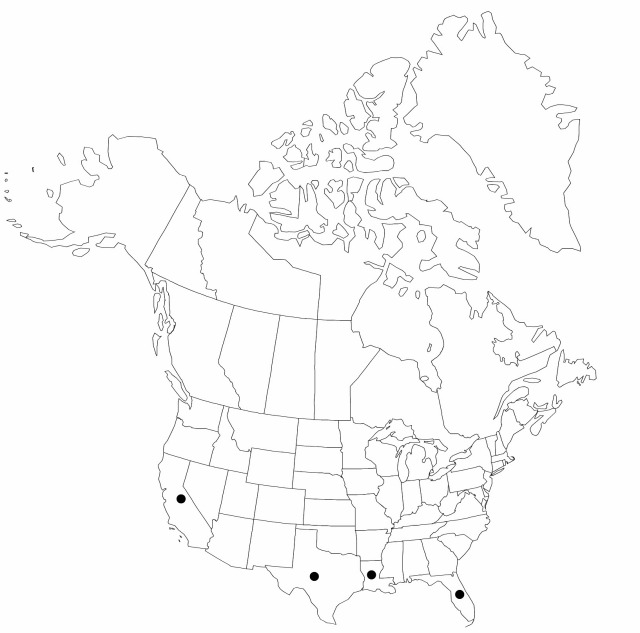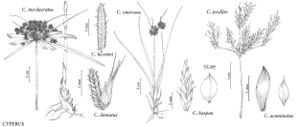Difference between revisions of "Cyperus involucratus"
Descr. Pl. Rar., 22. 1772.
FNA>Volume Importer |
imported>Volume Importer |
||
| (One intermediate revision by the same user not shown) | |||
| Line 8: | Line 8: | ||
}} | }} | ||
|common_names=Umbrella-plant | |common_names=Umbrella-plant | ||
| + | |special_status={{Treatment/ID/Special_status | ||
| + | |code=I | ||
| + | |label=Introduced | ||
| + | }}{{Treatment/ID/Special_status | ||
| + | |code=F | ||
| + | |label=Illustrated | ||
| + | }} | ||
|basionyms= | |basionyms= | ||
|synonyms= | |synonyms= | ||
| Line 24: | Line 31: | ||
|elevation=0–100(–800) m | |elevation=0–100(–800) m | ||
|distribution=Calif.;Fla.;La.;Tex.;e Africa. | |distribution=Calif.;Fla.;La.;Tex.;e Africa. | ||
| + | |introduced=true | ||
|discussion=<p><i>Cyperus involucratus</i> has been collected in New York (R. S. Mitchell and G. C. Tucker 1997).</p><!-- | |discussion=<p><i>Cyperus involucratus</i> has been collected in New York (R. S. Mitchell and G. C. Tucker 1997).</p><!-- | ||
--><p><i>Cyperus involucratus</i> is widely cultivated as a water plant in greenhouses and outdoors in warm-temperate or tropical climates. It has long been misidentified in the flora as C. alternifolius Linnaeus, an endemic of Madagascar (G. C. Tucker 1983).</p> | --><p><i>Cyperus involucratus</i> is widely cultivated as a water plant in greenhouses and outdoors in warm-temperate or tropical climates. It has long been misidentified in the flora as C. alternifolius Linnaeus, an endemic of Madagascar (G. C. Tucker 1983).</p> | ||
| Line 48: | Line 56: | ||
|publication title=Descr. Pl. Rar., | |publication title=Descr. Pl. Rar., | ||
|publication year=1772 | |publication year=1772 | ||
| − | |special status= | + | |special status=Introduced;Illustrated |
| − | |source xml=https:// | + | |source xml=https://bitbucket.org/aafc-mbb/fna-data-curation/src/2e0870ddd59836b60bcf96646a41e87ea5a5943a/coarse_grained_fna_xml/V23/V23_227.xml |
|genus=Cyperus | |genus=Cyperus | ||
|subgenus=Cyperus subg. Pycnostachys | |subgenus=Cyperus subg. Pycnostachys | ||
Latest revision as of 20:39, 5 November 2020
Herbs, perennial, cespitose, rhizomatous. Culms trigonous, 30–150 cm × 1–5(–8) mm. Leaves bladeless. Inflorescences: heads digitate, 15–30(–36) mm diam.; rays (14–)20–22, (2–)5–12(–20) cm; 2d order rays 0.3–3(–4) cm; 3d order rays sometimes present, 0.3–2.5 cm; bracts (4–)18–22, ± horizontal, flat, 15–27 cm × (1.5–)8–12 mm. Spikelets 8–20, ovoid to linear-lanceoloid, compressed, 5–25 × 1.5–2 mm; floral scales 8–28, laterally whitish or light brown, ± hyaline, medially light brown, laterally ribless, medially 3-ribbed, 2-keeled in proximal 30–60%, deltate-ovate, 1.6–2.4 × (1–)1.2–1.5(–1.7) mm, apex acute. Flowers: stamens 3; anthers 0.7–1 mm; styles 0.5–1 mm; stigmas 0.6–1 mm. Achenes brown, sessile or stipitate, broadly ellipsoid, 0.6–0.8 × 0.4–0.6 mm, stipe if present to 0.1 mm, apex obtuse, apiculate, surfaces puncticulate.
Phenology: Fruiting early summer–fall.
Habitat: Damp, disturbed soils, ditches, stream banks
Elevation: 0–100(–800) m
Distribution

Introduced; Calif., Fla., La., Tex., e Africa.
Discussion
Cyperus involucratus has been collected in New York (R. S. Mitchell and G. C. Tucker 1997).
Cyperus involucratus is widely cultivated as a water plant in greenhouses and outdoors in warm-temperate or tropical climates. It has long been misidentified in the flora as C. alternifolius Linnaeus, an endemic of Madagascar (G. C. Tucker 1983).
Selected References
None.
